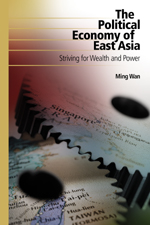Introduction
Karl Ho
School of Economic, Political and Policy Sciences
University of Texas at Dallas
Political Economy of Technology in East Asia
Why study Political Economy?
- Interplay between Politics and Economics
- Using Economic methods to study politics and political behavior, e.g.
- individuals
- countries
- organizations
- Economics and Political Science cannot be totally separated since politics defines the way resources are distributed.
Methodology
How do we study political economy?
- Understand the subject and data
- Unit of Analysis
- Individuals (rational choice approach)
- Organizations (historical institutionalism)
- Governments (both)
- Nations (sociological approach)
- Statistical methods/Econometrics + Political methodology
Readings: Wan 2020/2008
2008

2020
What is East Asia?
- Geography
- Countries
- China
- Japan
- Four tigers
- Hong Kong
- Singapore
- South Korea
- Taiwan
- North Korea
- Macau
Why study East Asia?

Why study East Asia?

- Leading Hub of Technological Innovation
- Geopolitics
- Unique Characteristics of East Asia’s Political Economy
- State-led Innovation Models
- Cultural and Institutional Factors
Why study East Asia?

Biggest/highest
- Population
- China: 1.4 billion
- GDP per capita (PPP)
- Singapore?
- Macau
- FDI received
- Hong Kong/China
- Foreign-exchange reserve
- China (~$3 trillion)
- Japan (2)
- Taiwan (6)
- Hong Kong (8)
East Asian countries and political economy classfications

East Asian countries and political economy classfications

Share of world GDP, 1980 and 2018


Share of world merchandise trade, 1980 and 2017
Approaches in studying institutions
- Rational Choice Approach
- Historical Institutionalism
- Sociological approach
Approaches in studying institutions
1. Rational Choice Approach
- Individual based
- “All individuals are goal-oriented, rational actors seeking maximization of gains and minimization of losses in a strategic environment”
- What happens if all people are irrational?
- Institution is established to facilitate cooperation (mutual benefits), which could be impossible otherwise.
Approaches in studying institutions
1. Rational Choice Approach
- Individual based
- “All individuals are goal-oriented, rational actors seeking maximization of gains and minimization of losses in a strategic environment”
- What happens if all people are irrational?
- Institution is established to facilitate cooperation (mutual benefits), which could be impossible otherwise.
Approaches in studying institutions
- Rational Choice Approach (continued)
- Institutions be in place to coordinate and facilitate cooperation so individual parties can benefit or benefit more than otherwise
- National policies can be followed
- Effective institutions explain success of economies
- International organizations can be functional
- MNCs and IGOs can work across borders
Approaches in studying institutions
2. Historical Institutionalism
- Historical origins of institutions: Time does matter.
- Path dependence: timing and sequence determine policy options and adoptions
- E.g. China in the 1960s and the 1970 reforms
- International distribution of power (e.g. West over East) explains distribution of resources (i.e. trade, exchange rates, etc.)
- National security is another determinant.
